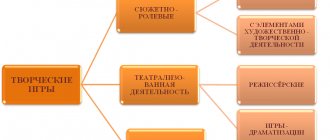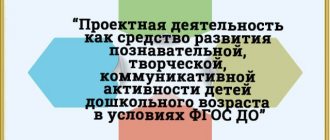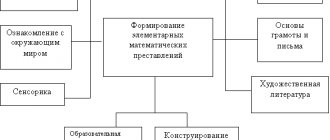“Organization of independent activities of preschool children in the context of the implementation of the Federal State Educational Standard”
#Educational and methodological materials #Presentation #Educator #Preschool education
“Pedagogical bag” (From work experience) “Organization of independent activities of preschoolers in the context of the implementation of the Federal State Educational Standard” Completed by: teacher of Municipal Educational Institution Kindergarten No. 359 O.A. Almyasheva
In the Federal State Educational Standard for Education, the independent activities of children are highlighted less clearly than the joint activities of adults and children. However, in the target guidelines, independence, the ability to choose one’s occupation, is paramount. The need for the formation and development of independence is dictated by the needs of society for non-standard people who can think creatively and make discoveries for the benefit of humanity. And the solution to this issue is reflected in the process of developing independence, which allows a person to pose new problems and find new solutions.
What conditions need to be created in a preschool educational institution for independent children’s activities? The construction of a subject-spatial environment by adults should make it possible to organize both joint and independent activities of children. In this case, the environment performs educational, developmental, nurturing, stimulating, organizational, and communicative functions. But most importantly, it works to develop the child’s independence and initiative.
Game Activity Center Design Center Patriotic Education Center
Fine Arts Center Book Center
Nature Center
Theater Center Musical class=”aligncenter” width=”800″ height=”600″[/img]
Traffic rules center
Our group has created a diverse gaming environment (subject-spatial environment), which provides the child with cognitive activity, corresponds to his interests and is developmental in nature. The created environment provides children with the opportunity to act individually or together with peers, without imposing mandatory joint activities. Every child has the opportunity to do what they love. Such an environment meets the individual and age characteristics of children and their leading activity – play.
Classification of games Children's games are very diverse. They differ in content and organization, rules, impact on the child, types of objects used, origin, etc. * Games that arise on the child’s initiative: - game-experimentation; - independent story game; Games that arise on the initiative of an adult: - educational: didactic, active, - leisure: game-fun, game-entertainment, theatrical, intellectual, festive-carnival; Games coming from the historically established traditions of the ethnic group: traditional or folk Creative games: plot-role-playing, construction-constructive, directing, dramatization games
Circles of Llull
Desktop layout "City"
Role-playing game "Driver's license" Passing exams at driving school Theory Practice
We undergo a medical examination
And here it is...a happy moment! Presentation of the certificate.
Role-playing game "Supermarket" Role-playing game "Atelier" Role-playing game "Hospital" Role-playing game "Barbershop"
Author’s, together with children “My City”
"Magic Tree"
“Checkers are friends with traffic rules”
“Cut pictures” “Memory” (pairs) “Assemble a sign” “CUBE”
“Sun and Snowman” (Art) “Decorate the Board” (Art) “Ladybugs” (Mathematics) Patriotic education
Play in a group is organized, firstly, as a joint game between the teacher and the children, where the adult acts as a playing partner and at the same time as a carrier of a specific “language” of the game. The natural emotional behavior of the teacher, who accepts any children’s plans, guarantees freedom and ease, the child’s enjoyment of the game, and contributes to the desire in children to master the methods of play themselves. Secondly, at all age stages, play is preserved as a free independent activity of children, where they use all the play tools available to them, freely unite and interact with each other, where the world of childhood is ensured to a certain extent, independent of adults.
Along with play, free productive activity of children (constructive, visual, etc.) occupies a significant place in a child’s life. Just like in play, the child’s development opportunities are enriched here. A circle “One palm, two palms” was organized
The next optimal condition for organizing independent children's activities is the special organization of educational activities. To do this, it is necessary to look for and apply more effective means of education and training that serve the development of children’s cognitive abilities. One of the promising methods is the design method.
Thus, the development of children's independence is one of the most important educational guidelines necessary for the successful socialization of the child and the development of his personality as a whole, and for creating a developmental and emotionally comfortable educational environment for him, in particular.
The teacher’s skill is most often manifested in organizing children’s independent activities. How to direct each child to a useful and interesting game without suppressing his activity and initiative? How to alternate games and distribute children in a group room or area so that they can play comfortably without disturbing each other? How to eliminate misunderstandings and conflicts that arise between them? The comprehensive upbringing of children and the creative development of each child depend on the ability to quickly resolve these issues.
Joint activities of teacher and children
Note 1
The joint activity of a teacher with children is one of the main models for organizing the educational process of preschool children. The activity of two or more participants in educational activities, that is, an adult and a student, aimed at solving educational problems in the same space and at the same time is characterized by the partner position of the adult and the partner organization of the child, that is, possible free placement, movement and communication in the process of educational activities.
The following forms of work with students are distinguished:
- individual;
- subgroup;
- frontal.
The following types of joint activities are also distinguished:
Are you an expert in this subject area? We invite you to become the author of the Directory Working Conditions
- directly educational activities, which are implemented in the joint activities of the teacher and children;
- joint activity of the teacher with children, which is carried out in the process of implementing routine moments and solves educational problems.
Types of joint activities:
- gaming;
- communicative;
- educational and research;
- productive.
The algorithm for the development of any type of activity is as follows: first, there is joint activity with teachers, and then joint activity with peers, and finally, the preschool child becomes an independent activity.
The characteristics of joint partnership between a teacher and children include:
- voluntary participation of children in activities, that is, there is no psychological and disciplinary coercion;
- open time periods - each child works at an individual pace;
- the possibility of free communication and movement of children;
- pedagogical support.
Taking into account the above-mentioned essential features of organizing joint activities, they should affect all routine moments carried out in the group, as well as all aspects of direct educational activities.
Finished works on a similar topic
Course work Joint and independent activities of teachers and children 400 ₽ Abstract Joint and independent activities of teachers and children 240 ₽ Test work Joint and independent activities of teachers and children 230 ₽
Receive completed work or specialist advice on your educational project Find out the cost
Achieving discipline within the framework of joint activities is possible only by using the informal authority of an adult, as well as by creating an integral system of interests, including the choice of topics of educational activity that are interesting and meaningful for the child.





